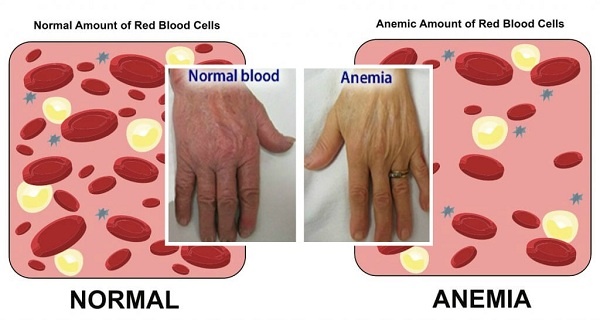Anemia
Anemia is a deficiency of erythrocytes with a corresponding reduction in the concentration of hemoglobin that results in reduced oxygen-carrying capacity of the blood. Some people with anemia may be asymptomatic initially, but eventually, the lack of oxygen to tissues results in fatigue, lethargy, shortness of breath, headache, edema, and tachycardia.

Common causes include blood loss, decreased functional red blood cell (RBC) production, and increased RBC destruction. Determination of the underlying cause of anemia is essential for successful management. Anemia is a common diagnosis with a prevalence that varies widely based on age, gender, and race/ethnicity. People with specific comorbidities such as cancer and chronic kidney disease have significantly higher rates of anemia. The incidence of anemia in cancer patients ranges from 30% to 90%. Contributing factors include the underlying malignancy and myelosuppressive antineoplastic therapy.
- Some patients with anemia have no symptoms. Those who do have symptoms may
- feel tired,
- become easily fatigued,
- appear pale,
- have a feeling of a heart racing,
- feel short of breath, and/or
- have worsening heart problems.
- Anemia can be detected with a simple blood test called a complete blood cell count (CBC).
- Anemia treatment varies greatly and depends on the particular cause
A decrease in erythrocyte production can be multifactorial. Nutritional deficiencies (iron, vitamin B12, and folic acid) are common causes and often easily treatable. People with cancer or Chronic kidney disease are at risk for developing anemia caused by dysregulation of iron and erythropoietin (EPO) hemostasis. People with chronic immune-related diseases such as rheumatoid arthritis and systemic lupus erythematosus are also at increased risk to develop anemia as a complication of their disease. Anemia related to chronic inflammatory conditions is termed anemia of chronic disease (ACD).
Causes of Low Hematocrit Blood Levels
A person who has a low hematocrit is referred to as being anemic. There are many reasons for anemia. Some of the more common reasons are:
Loss of blood:
- Traumatic injury
- Surgery bleeding
- Colon cancer
Nutritional deficiency:
- Iron
- Vitamin B12
- Folate

Bone marrow problems:
- Replacement of bone marrow by cancer
- Suppression by chemotherapy drugs
- Kidney failure
Abnormal hemoglobin:
- Sickle cell anemia

Treatment
The goal of anemia therapy is to increase Hgb to levels that improve red cell oxygen-carrying capacity, alleviate symptoms, and prevent complications from anemia. Normal Hgb values are 14.0 to 17.5 g/dL (140–175 g/L or 8.69–10.9 mmol/L) for males and 12.3 to 15.3 g/dL (123–153 g/L or 7.63–9.50 mmol/L) for females. It is important to note that continuation of therapy should be assessed primarily by resolution of clinical symptoms. People who experience a resolution in their symptoms (eg, shortness of breath, tachycardia, fatigue, dizziness,) may not require aggressive therapy to maintain their Hgb values within normal limits. The underlying cause of anemia must be determined and used to guide therapy. A complete blood count (CBC) is the laboratory evaluation that provides objective characteristics of RBCs useful in determining etiology and appropriate treatment. The mean corpuscular volume and determination of iron, ferritin, folate, and vitamin B12 levels are required to correctly diagnose a person with anemia.

The underlying cause of anemia must be determined and used to guide therapy. A complete blood count (CBC) is the laboratory evaluation that provides objective characteristics of RBCs useful in determining etiology and appropriate treatment. The gold standard treatment of Iron Deficiency Anemia is oral iron therapy that provides 150 to 200 mg of elemental iron daily in divided doses. Many different iron products and salt forms are available. Typically, iron sulfate is the most commonly used formulation. Iron supplementation resolves anemia by replenishing iron stores to levels necessary for RBC production and maturation.

